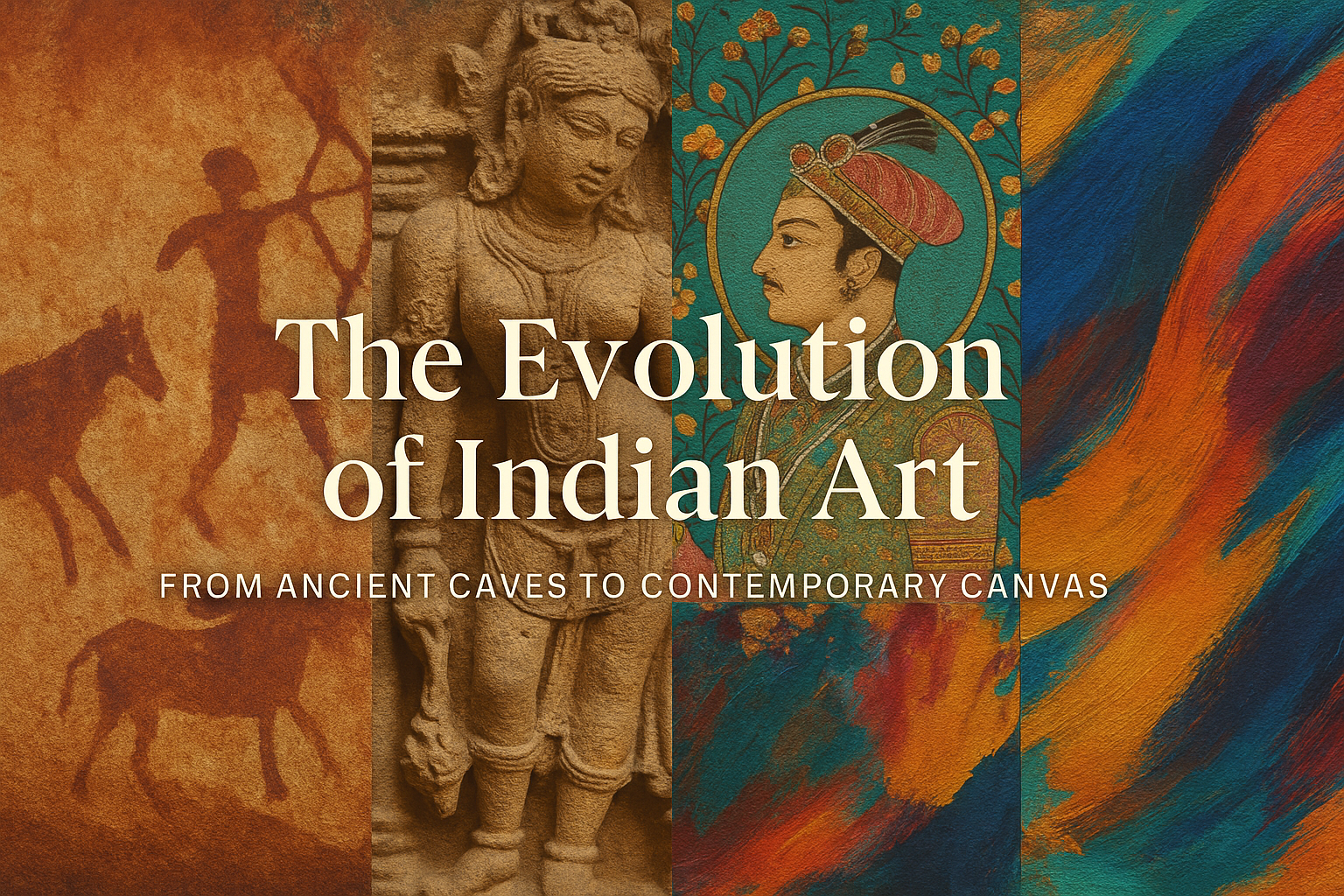Every brushstroke tells a story, one as ancient and diverse as India itself.
At Artsaisle, we believe art is more than decoration; it’s a window into centuries of culture, storytelling, and creative spirit.
If you’re passionate about art or choosing artwork for your home, understanding the evolution of Indian art will deepen your connection to every piece. Let’s journey through India’s artistic legacy, from prehistoric cave paintings to vibrant contemporary Indian art.
Prehistoric Indian Art: The Origins of Creativity
Indian art’s story begins in the depths of history. Over 30,000 years ago, artists painted scenes of hunting, animals, and daily life in the Bhimbetka Caves in Madhya Pradesh.
These prehistoric cave paintings:
- Used natural pigments like ochre, red, and white
- Showed early humans’ desire to tell stories through art
- Remain vivid even today, revealing India’s ancient artistic roots.
This earliest chapter in Indian art history reminds us how art has always been part of human life.
Classical Indian Art: Temples, Sculptures, and Spiritual Expression
Between the 3rd century BCE and 6th century CE, Indian art styles flourished under religious and royal patronage.
Buddhist Art
- The Ajanta cave paintings (5th century CE) in Maharashtra remain world-famous for their intricate lines and storytelling.
- These murals depict scenes from Buddha’s life and Jataka tales, using vibrant colors and graceful figures.
Hindu Art
- Indian temples became architectural masterpieces, covered with sculptures of gods, celestial dancers, and floral motifs.
- Sites like Khajuraho, Mahabalipuram, and Ellora showcase India’s devotion to sacred art.
This period shaped many traditional motifs still seen in Indian painting traditions today.
Medieval Indian Art: The Era of Miniatures and Mughal Influence
The medieval period brought significant changes as Islamic dynasties introduced Persian influences into Indian art.
Mughal Art
- Under Akbar, Jahangir, and Shah Jahan, Mughal miniature paintings became renowned for:
- Fine brushwork
- Lifelike portraits
- Rich jewel-like colors
- Mughal art beautifully merged Indian subjects with Persian styles, capturing royal courts, nature, and everyday life.
Rajput and Pahari Schools
- In regions like Rajasthan and Himachal Pradesh, local rulers nurtured unique Indian miniature painting styles.
- Rajput paintings featured bold colors and romantic themes, while Pahari art focused on delicate lines and spiritual narratives.
These schools remain iconic in Indian art history and inspire many modern artists.
Colonial Period: Blending Indian Art Styles and Western Techniques
During the British colonial era (18th–19th centuries), Indian art encountered European realism.
- Raja Ravi Varma, a celebrated figure in Indian painting traditions, blended:
- Western oil painting techniques
- Indian mythological subjects
- His works like Shakuntala remain beloved across generations.
- The British also commissioned “Company Paintings” to document India’s landscapes, people, and culture.
This era sparked debates about preserving traditional Indian art styles versus adopting European methods.
Modern Indian Art: Identity and Innovation
As India moved toward independence, artists sought new ways to express national identity through art.
Bengal School of Art
- Led by Abanindranath Tagore, the Bengal School revived traditional Indian esthetics.
- It rejected Western realism, focusing on soft washes and spiritual themes.
Progressive Artists’ Group
- After independence in 1947, artists like M.F. Husain, F.N. Souza, and S.H. Raza embraced modernism.
- Their work introduced:
- Abstract forms
- Bold colors
- Global art dialogues
This period marked a turning point for modern Indian artists, establishing India’s presence in global contemporary art.
Contemporary Indian Art: Tradition Meets Global Vision
Today, Indian contemporary art blends heritage with modern themes.
- Artists like Subodh Gupta, Bharti Kher, and Jitish Kallat explore identity, urbanization, and social issues.
- Street art transforms cities like Mumbai and Delhi into vibrant cultural canvases.
- Digital artists incorporate traditional motifs into modern designs, redefining Indian art styles for a global audience.
Contemporary modern Indian artists are pushing boundaries, making Indian art globally relevant.
Why the Evolution of Indian Art Matters for Your Space
At Artsaisle, we believe your art should tell your story—and carry pieces of the world’s stories too.
Understanding the evolution of Indian art helps you choose pieces that:
- Reflect your taste and values
- Add cultural depth and beauty to your home
- Celebrate India’s artistic legacy
From the delicate elegance of Mughal art to bold, abstract works by modern Indian artists, Indian art offers something for every aesthetic.
Explore Indian Art at Artsaisle
Indian art continues to evolve, bridging the past and the present. Each piece is more than pigment—it’s part of a story century in the making.
Which era of Indian art fascinates you most? Join the conversation below, or explore our collections inspired by India’s rich artistic journey.
At Artsaisle, we help you find art that feels uniquely yours—rooted in history, alive with modern creativity.

